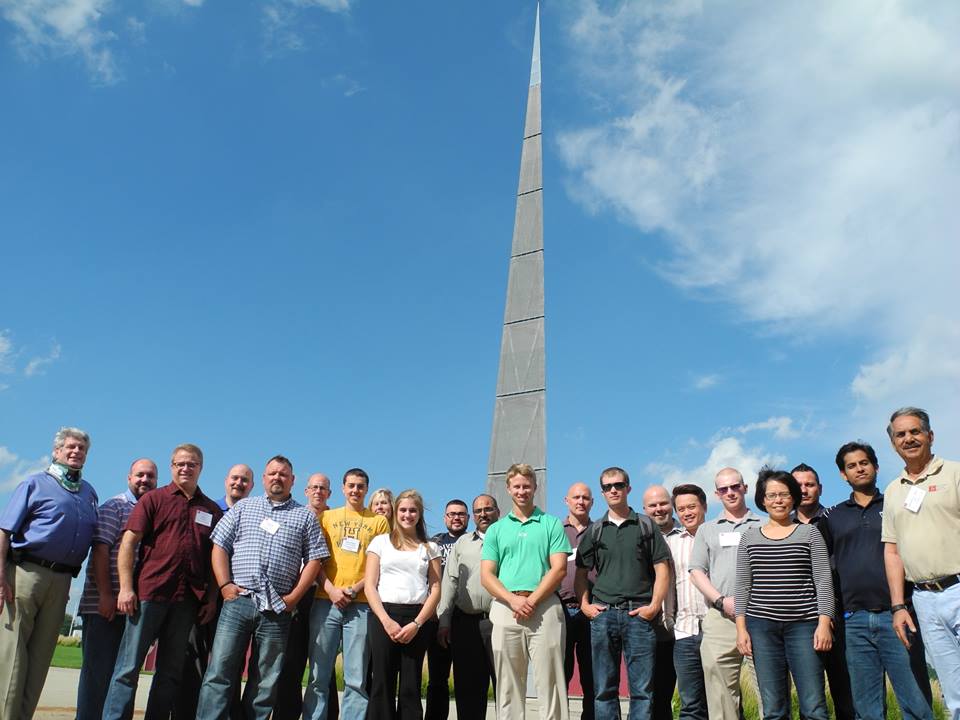
by Julie | Jan 4, 2017 | Employee Training, Management, Onboarding
UNDERSTANDING OUR ROLE IN ACHIEVING OUR GOALS
As 2016 comes to a close, it is time to set 2017 goals. Do you have in mind what you would like to achieve from a business perspective? Personally? In your relationships? Have you thought about how you are going to achieve your goals?
At a recent Vistage meeting, our chair asked each member of the group what our goals were for the upcoming year. And then he asked us to write down what we needed from the group in order to achieve those goals. But, then he shifted the perspective and asked what we were willing to give to the group in order to help achieve our goals.
I’ll be honest, this exercise made me uncomfortable. It was easy for me to give specifics about what they could do to help me succeed in 2017. But, as I shared with the group, the chair challenged me to answer what I would do to ensure the group could help me. After some gentle prodding, I had to admit that I would open myself up to their feedback and suggestions, even if it pushed me outside of my comfort zone.
As I reflected on this exercise, I started to realize the power in this shift in thought. It moves the conversation from ME (my goals) and YOU (what you are going to do to support me) to how WE can collectively be better.
As you set the goals for your business in 2017, have you thought about what you need from your organization in order to achieve those goals? Have you talked with your employees about their goals and what they need from you in order to achieve their goals? And then, have you asked what all of you are willing to give back to the organization in order to achieve those goals?

by Julie | Sep 1, 2016 | Employee Training, Management, Safety
It is back to school time. I remember when I was younger, I was thinking about what to wear for the first day of school, making sure I had the perfect outfit for the school yearbook. But, as I got older, my focus turned to the subjects that I was going to be studying. Some my questions were: How hard is the professor? How much homework will she give us? How many exams will we have to take? As I reflect back, I don’t remember thinking much beyond passing each course. In fact, in Linear Analysis, a 400-level math course, the professor actually said and I quote, “I know I have a lot of engineering students in this class and you are wondering what the practical application is for this subject and I will tell you – I have no idea.” And he was right – I have never used anything I learned in that class in the real world.
But, as we look at training our operators, it is important that the information that is being presented has a practical application that the operators can apply to their work and/or personal lives. This doesn’t just apply to the training around their daily tasks, but, it also applies to safety training, HR training and environmental training.
When presenting training to operators, try to tie in real world experiences to the material. In the past, when conducting ladder safety training – I talked about how I almost fell off a ladder while cleaning my gutters at my house. Or when discussing PPE, I talk about the importance of wearing safety glasses, even when working on projects at your home. When discussing environmental training, I include tips on how to dispose of hazardous household chemicals.
If the training material is something that the operator can personalize and understand why it is important, at work or in his personal life, the training will have a much greater impact.
And if you do that, I am sure your operators will be more engaged and receptive than I was in Linear Analysis.
For more practical tips for manufacturing professionals to attract, train and retain your hourly workforce, go to www.keyprocessinnovations.com.

by Julie | Aug 25, 2016 | Employee Training, Management
CAN ANYONE SAY CAFFEINE?
Last week, I had the pleasure of being an instructor for the Investment Casting Institute’s Process Control Seminar. We had students from all over North America come together at Western Michigan University to learn how to apply process control tools in the three major areas of the investment casting process: wax, shell and foundry.
The structure of the course was for investment casting, but, there are definitely some takeaways which can be applied to all employee training.
- Provide multiple methods of learning. As I have previously discussed, everyone learns differently, so make sure you include visual, auditory and kinesthetic learning. Whenever possible, instructors should incorporate activities so the students can apply what they were learning.
- Tie the training back to something that can impact their jobs. Adults want to know that the effort in learning something new is worth it.
- Ensure the instructors are prepared and comfortable with the material they are presenting. We all know what an impact a great instructor can have on learning.
- Provide the training materials in different formats. Some people want their training materials electronically, while others prefer to have hard copies.
- Make sure caffeine is available throughout the day. Very few people are accustomed to sitting and listening to lectures for an entire day. Providing some stimulants, including chocolate, can help keep students focused.
- Control the environment. This includes the temperature of the room, noise in the hallways and conversations amongst students during the lectures.
- Get feedback on what can be improved. The perspective of the course should be evaluated from all angles, not just from the instructor. After the course, make sure to conduct a de-brief with the instructors while their experience is still fresh in their minds.
For more practical tips for manufacturing professionals to attract, train and retain your hourly workforce, go to www.keyprocessinnovations.com.

by Julie | Jul 14, 2016 | Efficiency, Employee Training, Management, Process Improvement
GETTING THE MOST OUT OF YOUR TECHNOLOGICAL IMPROVEMENTS
A member of my family recently purchased a new car with all the bells and whistles. This car came with a navigation system, internet access, adaptive cruise control and forward collision warning. Learning all the technology was overwhelming. But, what my family member forgot was that the primary purpose of the vehicle was to drive him from Point A to Point B. As you can imagine there were a few near misses as he learned how to handle all the technology right at his fingertips.
Learning new systems or technology can be challenging, especially if the person isn’t particularly tech savvy. As the individual focuses on learning the newly installed systems, he may lose focus on other important tasks such as safety or product quality. Understanding and planning for this loss of focus is important as new technology is introduced to your operators. This may require a reduction of throughput during the initial learning curve or possibly staffing additional operators so throughput and/or quality aren’t compromised.
As you develop your training plan, make sure to incorporate as many senses as possible including auditory, visual and kinesthetic. Everyone learns a little differently and incorporating different senses can increase the speed at which an operator learns the necessary information. Never don’t underestimate the importance of hands-on learning.
When you train your employees on the new systems, keep an eye out for the operators who appear to be struggling. If you are picking up on it, then their peers probably are as well and this can result in anxiety and a reduction of focus by the struggling employee(s). Consider some contingency plans for these employees where they can get additional training without being scrutinized by their peers.
Technology can be an asset to a manufacturing plant, but, make sure that you incorporate the necessary operator training systems so you can realize all the benefits without a negative impact to operator safety or product quality.
For more practical tips for manufacturing professionals to attract, train and retain your hourly workforce, go to www.keyprocessinnovations.com.

by Julie | Jul 6, 2016 | Efficiency, Employee Training, Management, Process Improvement
Understanding Your Operators Resistance to Change
How many times have you heard the phrase, “I’ve been doing this for over 20 years and this hasn’t been an issue before” Or “What makes you think we need to change this now?” I think those phrases are code words that could touch on some underlying issues including:
- Fear of change. This fear can be twofold: what I have been doing all these years has been wrong so now I have to change or what I thought was secure is now changing leading potentially to some period of uncertainty. Preparing employees for change can help them overcome this fear. I have conducted change management seminars to help management teams adjust to shifts in the workplace. But, I also know that change gets easier the more it is experienced. So, if you are sensing resistance from your team, you might want to make some small changes which can help your operators adapt to an ever-changing work place. Or, if a large change is planned, take the time to train your operators on why change is necessary along with suggestions on how to manage the stress of change.
- Mistrust. Most long-term employees have been doing the same thing for many years and now, you are asking them to change. Questions I have heard include: Why do you all of sudden think that I need to make a change?What is your motivation for making me change? Are you are trying to make yourself look good and me look bad? Operators, especially long timers, are observant. If they sense that management isn’t being honest with them, they will fight the changes that are being implemented. An attitude of open, honest and consistent communication will go a long way towards overcoming mistrust.
- Prejudice. After a certain amount of time, adults will develop an attitude towards an individual or group of individuals which will frame their thinking. These prejudices can impact an adult’s willingness to adopt new ideas. As a young engineer, I heard over and over again, typically in a sarcastic tone, “Oh, the engineer is here to tell us what we are doing wrong.” In order to overcome these prejudices, I spent time listening to the operators, asking for their input and implementing some of their ideas. Yes, it took time, but, eventually, I found these operators much more willing to work with me. However, these prejudices won’t go away overnight and require a willingness from all parties to work together and make sure each side is being heard and understood.
As you approach training of your workforce, it is important to keep these potential issues in mind. Put yourself in your employee’s place and think about the best approach to introducing new methods and concepts. The more time that is spent developing the training and addressing some of the underlying concerns, the greater the impact the training can have on your workforce.
For more practical tips for manufacturing professionals to attract, train and retain your hourly workforce, go to www.keyprocessinnovations.com.

by Julie | Jun 29, 2016 | Efficiency, Employee Training, Management
TIPS TO KEEP MILLENNIALS ENGAGED IN THE WORKPLACE
I recently had an opportunity to serve as judge for a STEM (Science, Technology, Engineering and Mathematics) middle school project titled “The School of the Future.” The project was based on 4 criteria: the learning environment, the physical environment, community interaction and environmental impact. Some of the students had amazing ideas and designs while some of them didn’t seem to embrace the project. As I listened to over 30 presentations, I started to pick-up on some themes including:
- Students find value in project based learning. They reject the notion that they need to learn individually.
- They want to be in control of their curriculum
- Most of their research is done on Google
- They believe that learning should be fun
- Utilizing technology is important
- Protecting the environment is a priority for them
I’m not suggesting that I completely agree with them and there were times when I questioned their thought process. But, it was an interesting glimpse into how millennials think.
So, how does that impact us in the work place? This is a different generation and they aren’t going to think like we do. So, we need to adapt our approach so we can keep them engaged. Some suggestions on how to do this include:
- Consider providing opportunities for your employees to work together on a project, such as Kaizen events, department specific 5S or even utilizing process improvement tools such as Brainstorming/Cause and Effect Diagrams.
- Incorporate technology into your plant. This doesn’t need to be a complete overhaul of your plant. Some less expensive ways to use technology to engage your employees could be a company e-newsletter developed by your employees, or transition training into an interactive portal where they can establish their own curriculum and schedule (within reason, of course).
- When you do conduct live training, ensure it is interesting and engaging. If it isn’t, check out this article on ways to improve it.
- Identify a company sponsored project outside of the plant to help millennials feel engaged at work. Perhaps your company can get involved with Earth Day, or some other cause that resonates with your employees, industry and/or your community.
Millennials aren’t going to change and it is up to us to modify our approach so they can stay engaged at work. Because, if we don’t, they will find an employer who will adapt their approach to meet their needs.
For more practical tips for manufacturing professionals to attract, train and retain your hourly workforce, go to www.keyprocessinnovations.com.

by Julie | Jun 22, 2016 | Consulting, Employee Training, Interim Management, Management, Process Improvement
USING INTERNAL AUDITS TO OPTIMIZE YOUR PROCESS
I’ll be honest, I’d be embarrassed if you ever saw my work shop. I tend to be one of those people who works around my messes. I don’t normally detect how dirty my workspace is until my husband gently suggests that I might work a bit more efficiently if I cleaned up my work bench before starting on another project.
I believe we are all guilty of looking past what we see on a daily basis. That is why audits are so important. An outside set of eyes can see areas that we may overlook. Internal audits can be structured in a number of different ways but must include a system for follow-up. Over my time in manufacturing, I have seen audits implemented in a number of effective ways, including the following:
- Management Gemba Walk – This can be an effective tool to demonstrate to the workforce a sense of unity within the management team. In addition, when issues are identified, all the managers can collectively decide how to address the issue.
- Safety Audits – These are typically conducted by members of the EH&S committee and are focused on potential safety or environmental hazards. Getting employees involved in this committee can greatly enhance the effectiveness of these types of audits.
- Layered Process Audits – LPAs are conducted on specific processes by individuals who don’t work in the department being audited. This gives a set of eyes that may detect issues that department employees may overlook. In addition, it provides employees exposure to other departments within the plant.
- Quality Systems Audit – this audit can be used to make sure the quality system is being followed. These are typically conducted by personnel trained on the Quality Measurement System and are focused on ensuring conformance to company policies and regulatory requirements.
Regardless of the type of audits that are conducted in your plant, make sure there is a mechanism in place to ensure that identified issues are addressed. Without this, the audits may lose their intended purpose.
For more practical tips for manufacturing professionals to attract, train and retain your hourly workforce, go to www.keyprocessinnovations.com.

by Julie | Jun 10, 2016 | Efficiency, Employee Training, Management, Process Improvement
BENEFITS FOR HAVING A CROSS-TRAINED WORKFORCE
If you are like me, you have summer on your mind. This is my favorite time of the year in the Northwest – the rain stops and the sun comes out. Long days, warm nights. And family vacation season!
Without good cross training, productivity of your plant may suffer when employees take their vacations. In order to avoid any negative impacts, some companies allow employees to skip their vacations and pay them for the week. That might seem like a tempting practice as it reduces the burden of having to cross train and increases the take home pay of the employee, but studies show that without taking time off, employees are more likely to make mistakes, increase health issues or burn themselves out.
A cross-trained workforce is the key to covering vacations as it provides the flexibility to move employees between departments. But, cross-training takes time. And since vacation season is upon us, I put together a list of other suggestions to help manage the vacation season so both the employee and the employer remain healthy:
- Have an up-to-date skills matrix. A skills matrix allows at a quick glance to see which positions are the most vulnerable. Using this matrix, you can approve vacation requests ensuring sufficient coverage for each position. For more information on how to establish a skills matrix, check out this article.
- Provide employees an opportunity for refresher training so they remember how to do a particular job before they are moved to fill in for a vacationing co-worker.
- Hire high school or college students on summer break. Manufacturing jobs are typically better paying jobs than fast food and it is a great way for them to get a taste for your company or industry.
- Consider an all plant shut-down. This has the advantage of not having to cover vacations and allows for annual maintenance. However, it doesn’t provide flexibility for the employee who may want to vacation outside of the shutdown window.
- Flex the work week. Perhaps moving to 4-10 hour days or staggering shift start times will give extra time for employees to enjoy with their families.
At the end of the summer, set up some time with your team to discuss what went well and what could be improved upon. And use the fall and winter to make improvements so next summer, you will be Having Fun in the Sun!
For more practical tips for manufacturing professionals to attract, train and retain your hourly workforce, go to www.keyprocessinnovations.com.

by Julie | Jun 3, 2016 | Consulting, Employee Training, Management, Process Improvement
CAPTURING THE NUANCES OF YOUR SKILLED WORKERS
In a survey recently conducted by AKT and the Northwest Food Processors Association, manufacturers expressed concern about finding employees with the necessary skills to fill open positions while nearly all respondents admitted their operator training program has room for improvement.
One of the challenges in training a new operator is teaching those “soft” skills to do a task. There is often an art to doing a task that can be hard to learn. This art may be a technique to reduce physical fatigue, troubleshooting a piece of equipment or evaluating a part prior to processing.
So, how do you capture those soft skills and effectively transfer them to a new employee? One technique that has worked well is to video the skilled operator performing the task. If it is a repetitive task, capture the task multiple times looking for differences. These may highlight some of the nuances that need to be captured. Taking video from different angles may also pick up subtle differences.
Once complete, review the video with the operator and have him explain what he is doing and why. Look for small movements which could be overlooked. These may include shifting weight from one leg to another, rotating the part in his hand as part of his inspection process or verifying fixture set-up before every part.
Incorporate the what and why from your skilled operator into your training documentation including procedures, standard work or even training videos. Once complete, have a different operator perform the task following the updated documentation. Incorporate his comments and then try it again. It may take a few iterations, but, eventually, you will have the necessary materials to assist in training new operators.
So, where should you start? I would begin with the position that has the greatest impact to the business. It will take some time to complete, but, establishing a process and getting started will help reduce some of your business exposure.
Click here if you are interested in reading the entire survey conducted by AKT and NWFPA.
For more practical tips for manufacturing professionals to attract, train and retain your hourly workforce, go to www.keyprocessinnovations.com.









